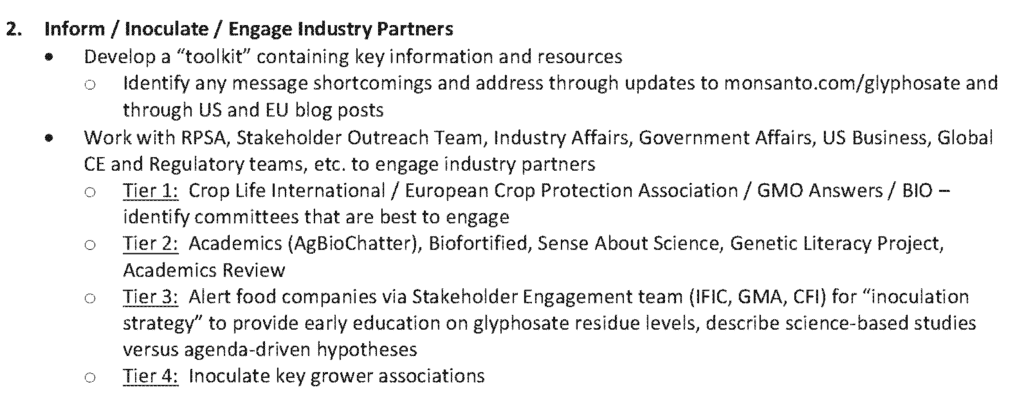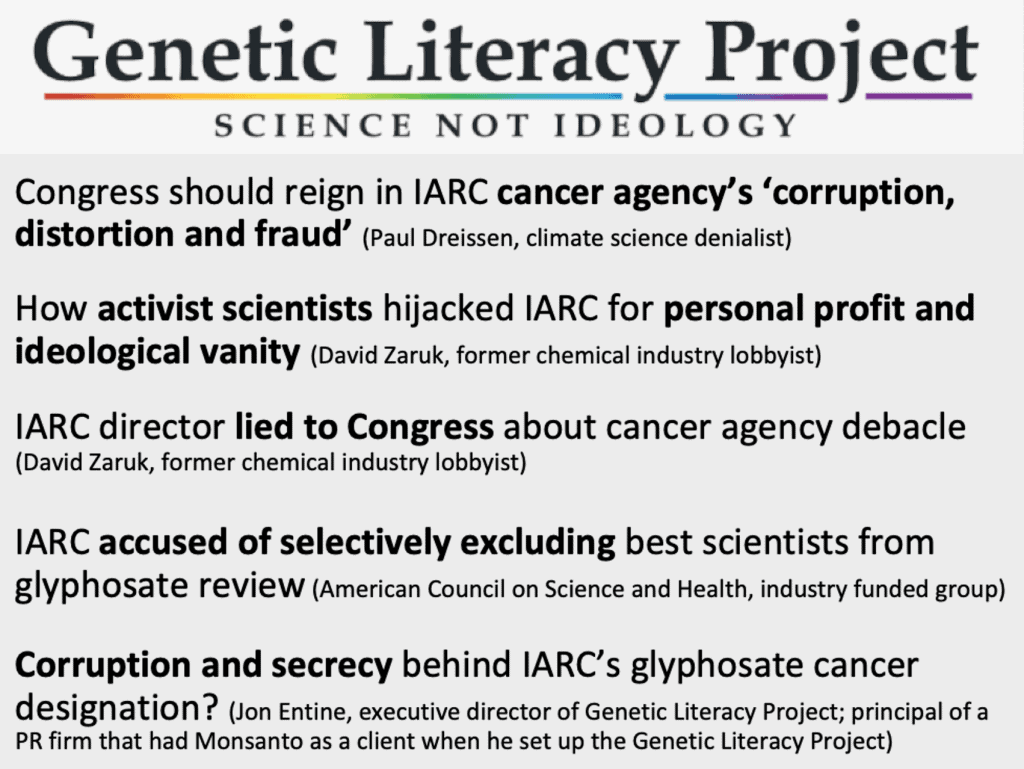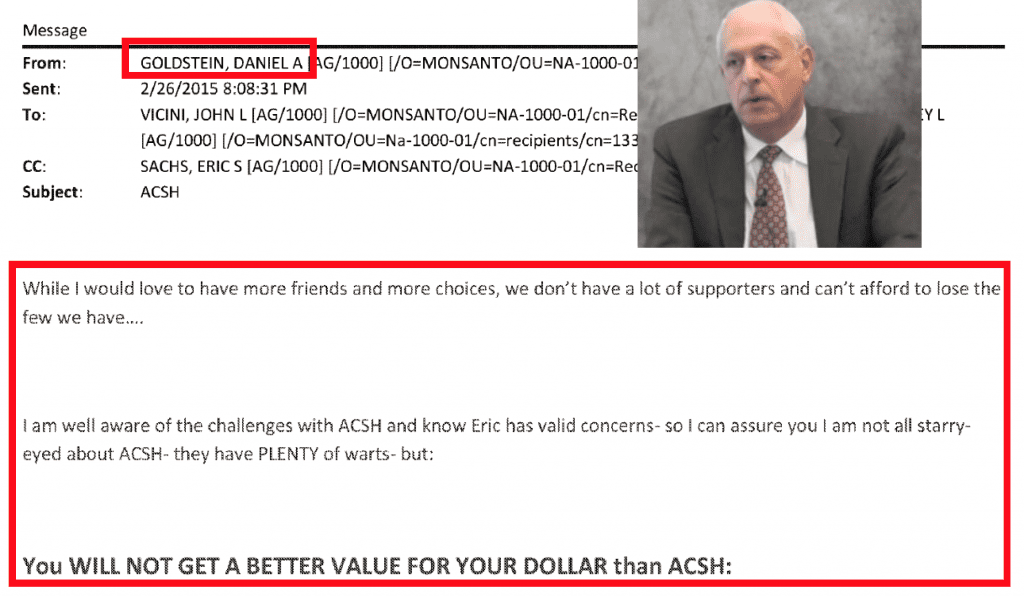In a confidential public relations plan dated February 2015, Monsanto laid out is plans to discredit the World Health Organization’s cancer research unit, the International Agency for Research on Cancer (IARC). A month later, the international group of experts judged glyphosate — the key ingredient in Monsanto’s Roundup weed killer — to be probably carcinogenic to humans.
The Monsanto plan names more than a dozen “industry partner” groups the company planned to “inform /inoculate / engage” in their efforts to protect the reputation of Roundup, prevent the “unfounded” cancer claims from becoming popular opinion, and “provide cover for regulatory agencies.” Partners included professors along with chemical and food industry front groups, trade groups and lobby groups.
Follow the links below to fact sheets that provide more information about the partner groups. Together these fact sheets provide a sense of the depth and breadth of the coordinated corporate attack against IARC scientists to protect Monsanto’s top-selling herbicide.

What was Monsanto’s plan?
Monsanto’s public relations plan to protect Roundup from the IARC cancer report assigns more than 20 Monsanto staffers to objectives including “neutralize impact of decision,” “regulator outreach,” “ensure MON POV (point of view)” and “lead voice” in defining “who is IARC” and to cause “outrage” about the cancer panel’s decision to classify glyphosate as a probable human carcinogen.
For more background: How Monsanto manufactured outrage at chemical cancer classification it expected,” by Carey Gillam, Huffington Post (September 2017); Secret documents expose Monsanto’s war on cancer scientists, by Stacy Malkan, USRTK (October 2018)
Monsanto engaged many ‘industry partners’ to defend glyphosate
Page 5 of the Monsanto document identifies four tiers of “industry partners” that Monsanto executives planned to engage in its defense plan to protect glyphosate and whip up “outrage” against the IARC cancer scientists and their report. These groups together have a broad reach and influence in their efforts to protect corporate profits and downplay cancer risk from glyphosate and other products.
The Monsanto plan identifies four tiers of “industry partners.” Below you will find fact sheets with more information about the groups listed here.

Tier 1: pesticide industry lobby and PR groups:
- CropLife International / European Crop Protection Association are pesticide industry trade groups
- GMO Answers is a crisis management marketing website funded by Monsanto, BASF, Bayer, Dow, Dupont and Syngentaand run by Ketchum public relations firm
- Biotechnology Innovation Organization is a biotech industry trade group
Tier 2: pesticide industry-connected front groups that are often inaccurately cited as independent sources. Documents establish that these groups work with pesticide companies behind the scenes to aid with PR and lobbying:
Tier 3: food industry spin groups: The following groups were tapped to, “Alert food companies via Stakeholder Engagement team (IFIC, GMA, CFI) for ‘inoculation strategy’ to provide early education on glyphosate residue levels, describe science-based studies versus agenda-driven hypotheses” of the independent cancer panel.
- International Food Information Council (IFIC) is a food industry-funded spin group that leads a coalition of 130 groups that coordinate messaging about GMOs and pesticides.
- Grocery Manufacturers Association (GMA) is the leading trade group for junk food companies.
- The Center for Food Integrity (CFI) is a food industry-funded spin group.
Tier 4: “key grower’s associations”: This refers to commodity trade groups representing corn, soy and other industrial growers and food manufacturers. According to a 2021 analysis by U.S. Right to Know, these groups spend tens of millions of dollars a year on efforts to defend and expand chemical-intensive corn and soy crops, nearly all of which are genetically modified to tolerate glyphosate in the U.S.
Front groups ‘orchestrate outcry’ against cancer scientists
Monsanto’s PR document described plans to conduct robust media and social media outreach to “orchestrate outcry with the IARC decision.” How this played out: industry partner groups used common messaging, and referred to each other as sources, to accuse the IARC cancer panel of wrongdoing and to personally attack the scientists who worked on the glyphosate report, in an attempt to discredit them.
Examples can be found on the website of the Genetic Literacy Project, a group that claimed at the time to be independent of industry but now discloses funding by Bayer (which bought Monsanto in 2018). website. This is a classic front group tactic: moving a company’s messaging through a group that claims to be independent while it works hand-in-glove with industry groups.

Hundreds of articles on the Genetic Literacy Project website are critical of IARC and many of these are written by industry-connected sources. For more information, see our reporting on the how Monsanto and Bayer led attacks against scientists to protect Roundup.
Sense About Science tapped to ‘lead industry response’
The PR document shows that Monsanto planned to conduct robust media and social media outreach to “orchestrate outcry with the IARC decision.” The plan suggests the group Sense About Science to lead the “industry response” and provide a “platform for IARC observers and industry spokesperson.” This is another clear example of the classic front group technique: pushing industry messaging from under the cover of a group that presents itself to journalists as an independent source.

Sense About Science is a public charity based in London that claims to promote public understanding of science, but the group is “known to take positions that buck scientific consensus or dismiss emerging evidence of harm,” reported Liza Gross in The Intercept. Sense About Science launched a US version in 2014 under the direction of Trevor Butterworth, a writer several journalists have accused of conducting PR for chemical companies.
Sense About Science is a sister group to the Science Media Centre, a PR agency in London that receives corporate funding and is known for pushing corporate views of science. A reporter with close ties to the Science Media Centre, Kate Kelland, published several articles in Reuters critical of the IARC cancer agency and accusing IARC scientists of wrongdoing; the reporting was based on false narratives and inaccurate, incomplete reporting, according to our analysis Documents later surfaced showing how Kelland received exclusive materials from Monsanto executives, and did not disclose this to her readers.
For more information:
- New Monsanto documents expose cozy connection to Reuters reporter, USRTK (January 2019)
- IARC rejects false claims in Reuters article, IARC statement (March 2018)
- Reuters’ Aaron Blair IARC story promotes false narrative, USRTK (July 2017)
- Reuters’ claim that IARC “edited out” findings is also false, USRTK (October 2017)
- Are corporate ties influencing Reuters science coverage? Fairness and Accuracy in Reporting (July 2017)
‘Engage Henry Miller’
Page 2 of the Monsanto PR document identifies the company’s first external deliverable for defending glyphosate from cancer concerns: “Engage Henry Miller” to “inoculate / establish public perspective” to discredit the IARC cancer panel.
“I would if I could start with a high-quality draft.”
Miller to Monsanto
Henry I. Miller, MD, a former fellow at the Hoover Institution and founding director of the FDA’s Office of Biotechnology, has a long documented history of working with corporations to defend hazardous products. The Monsanto plan identifies the Monsanto “owner” of the task to engage Miller as Eric Sachs, Monsanto’s science, technology and outreach lead.
Documents later reported by The New York Times reveal that Sachs emailed Miller a week before the IARC glyphosate report to ask if Miller was interested in writing about the “controversial decision.” Miller responded, “I would if I could start with a high-quality draft.”On March 23, Miller posted an article on Forbes that “largely mirrored” the draft provided by Monsanto, according to the Times. Forbes severed its relationship with Miller in the wake of the ghostwriting scandal and deleted his articles from the site.
Paying American Council on Science and Health
The American Council on Science and Health (ACSH), a long-known corporate front group that defends toxic products, did not appear in the Monsanto glyphosate-defense PR document, but emails establish the group worked behind the scenes with Monsanto — and received funding from Monsanto — to defend glyphosate. The emails indicate that Monsanto executives were uncomfortable about working with ACSH but did so anyway because, “we don’t have a lot of supporters and can’t afford to lose the few we have.”
Monsanto’s senior science lead Daniel Goldstein wrote his colleagues, “I can assure you I am not all starry eyed about ACSH- they have PLENTY of warts- but: You WILL NOT GET A BETTER VALUE FOR YOUR DOLLAR than ACSH” (emphasis his). Goldstein sent links to dozens of ACSH materials promoting and defending GMOs and pesticides that he described as “EXTREMELY USEFUL.”

For more on this topic, see our 2021 report, Merchants of Poison: How Monsanto Sold the World on a Toxic Pesticide, by Stacy Malkan with Anna Lappé and Kendra Klein, PhD.
U.S. Right to Know has donated many of the documents obtained in our investigations to the University of California, San Francisco, Chemical Industry Documents Library.









